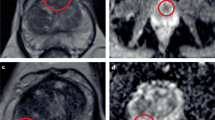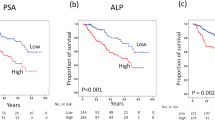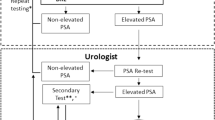Abstract
Prostate cancer has a varied natural history. Men with similar serum prostate-specific antigen (PSA) levels, clinical stages, and histologic features in their tissue specimens can have markedly different outcomes. While prostate cancer is lethal in some patients, most men die with cancer rather than because of it. Moreover, histologically apparent cancer can be found in the prostate glands of approximately 42% of men over 50 years of age who die from other causes, but the lifetime risk that a man in the US will be diagnosed with prostate cancer is estimated to be 11% and the risk of dying from the disease is only 3.1%. Consequently, appropriate disease management requires risk assessment. How likely is it that a given man's cancer will progress or metastasize over his remaining lifetime? What is the probability of successful treatment? What are the risks of adverse effects and complications of each treatment? Physicians use a variety of clinical and pathologic parameters to assess the risk that a given cancer poses to an individual patient. In addition to the accepted parameters of serum PSA level, clinical staging, and pathologic grading and staging, PSA doubling time has emerged as an important factor in the evaluation of men with newly diagnosed prostate cancer or prostate cancer that recurs after treatment. PSA doubling time can also be used as a surrogate marker for prostate cancer-specific death. This review summarizes current knowledge regarding the role of PSA doubling time as a prognostic marker in men with prostate cancer.
This is a preview of subscription content, access via your institution
Access options
Subscribe to this journal
Receive 12 print issues and online access
$209.00 per year
only $17.42 per issue
Buy this article
- Purchase on Springer Link
- Instant access to full article PDF
Prices may be subject to local taxes which are calculated during checkout





Similar content being viewed by others
References
Kattan MW et al. (2003) Counseling men with prostate cancer: a nomogram for predicting the presence of small, moderately differentiated, confined tumors. J Urol 170: 1792–1797
Partin AW et al. (1997) Combination of prostate-specific antigen, clinical stage, and Gleason score to predict pathological stage of localized prostate cancer. A multi-institutional update. JAMA 277: 1445–1451
Kattan MW et al. (1998) A preoperative nomogram for disease recurrence following radical prostatectomy for prostate cancer. J Natl Cancer Inst 90: 766–771
Kattan MW et al. (2000) Pretreatment nomogram for predicting the outcome of three-dimensional conformal radiotherapy in prostate cancer. J Clin Oncol 18: 3352–3359
Kattan MW et al. (2001) Pretreatment nomogram for predicting freedom from recurrence after permanent prostate brachytherapy in prostate cancer. Urology 58: 393–399
Pound CR et al. (1999) Natural history of progression after PSA elevation following radical prostatectomy. JAMA 281: 1591–1597
D'Amico AV et al. (2003) Surrogate end point for prostate cancer-specific mortality after radical prostatectomy or radiation therapy. J Natl Cancer Inst 95: 1376–1383
Memorial Sloan-Kettering Cancer Center predication tools [http://www.mskcc.org/predictiontools]
Epstein JI et al. (1998) Nonpalpable stage T1c prostate cancer: prediction of insignificant disease using free/total prostate specific antigen levels and needle biopsy findings. J Urol 160: 2407–2411
Choo R et al. (2002) Feasibility study: watchful waiting for localized low to intermediate grade prostate carcinoma with selective delayed intervention based on prostate specific antigen, histological and/or clinical progression. J Urol 167: 1664–1669
Klotz L (2005) Active surveillance with selective delayed intervention using PSA doubling time for good risk prostate cancer. Europ Urol 47: 16–21
Egawa S et al. (2000) Use of pretreatment prostate-specific antigen doubling time to predict outcome after radical prostatectomy. Prostate Cancer Prostatic Dis 3: 269–274
American Society for Therapeutic Radiology and Oncology Consensus Panel (1997) Consensus statement: guidelines for PSA following radiation therapy. Int J Radiat Oncol Biol Phys 37: 1035–1041
D'Amico AV et al. (2002) Biochemical outcome after radical prostatectomy or external beam radiation therapy for patients with clinically localized prostate carcinoma in the prostate specific antigen era. Cancer 95: 281–286
Stephenson AJ et al. (2004) Salvage radiotherapy for recurrent prostate cancer after radical prostatectomy. JAMA 291: 1325–1332
Ward JF et al. (2004) Prostate specific antigen doubling time subsequent to radical prostatectomy as a prognosticator of outcome following salvage radiotherapy. J Urol 172: 2244–2248
D'Amico AV et al. (2002) Determinants of prostate cancer-specific survival after radiation therapy for patients with clinically localized prostate cancer. J Clin Oncol 20: 4567–4573
D'Amico AV and Hanks GE (1993) Linear regressive analysis using prostate-specific antigen doubling time for predicting tumor biology and clinical outcome in prostate cancer. Cancer 72: 2638–2643
Zelefsky MJ et al. (2005) Outcome predictors for the increasing PSA state after definitive external-beam radiotherapy for prostate cancer. J Clin Oncol 23: 826–831
Pollack A et al. (1994) Prostate specific antigen doubling time and disease relapse after radiotherapy for prostate cancer. Cancer 74: 670–678
Ward JF et al. (2003) The long-term clinical impact of biochemical recurrence of prostate cancer 5 or more years after radical prostatectomy. J Urol 170: 1872–1876
D'Amico AV et al. (2003) Surrogate end point for prostate cancer-specific mortality after radical prostatectomy or radiation therapy. J Natl Cancer Inst 95: 1376–1383
D'Amico AV et al. (2004) Prostate specific antigen doubling time as a surrogate end point for prostate cancer specific mortality following radical prostatectomy or radiation therapy. J Urol 172: S42–S46
Roberts SG et al. (2001) PSA doubling time as a predictor of clinical progression after biochemical failure following radical prostatectomy for prostate cancer. Mayo Clin Proc 76: 576–581
Rabbani F et al. (1999) Prostate specific antigen doubling time after radical prostatectomy: effect of neoadjuvant androgen deprivation therapy. J Urol 161: 847–852
Trapasso JG et al. (1994) The incidence and significance of detectable levels of serum prostate specific antigen after radical prostatectomy. J Urol 152: 1821–1825
Author information
Authors and Affiliations
Corresponding author
Ethics declarations
Competing interests
The author declares no competing financial interests.
Rights and permissions
About this article
Cite this article
Eastham, J. Prostate-specific antigen doubling time as a prognostic marker in prostate cancer. Nat Rev Urol 2, 482–491 (2005). https://doi.org/10.1038/ncpuro0321
Received:
Accepted:
Issue Date:
DOI: https://doi.org/10.1038/ncpuro0321



